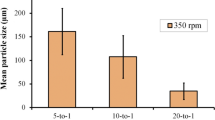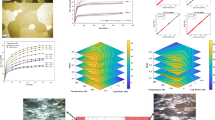Abstract
Optimization of casting parameters is essential in terms of quality factors in foundries. Nowadays, to optimize process parameters, new approaches such as artificial neural networks method are being used. In this study, a neural network model has been developed to control the grain size in aluminum casting alloys. Some of the important grain refinement parameters such as casting temperature, holding time and addition level have been evaluated as inputs for the model. The network training architecture was optimized at 241 training cycles with quasi-Newton algorithm with a single hidden layer and 6 neurons. With modeling, mean absolute percent error was found at 0.99 between experimental measurements and model estimation. R2 value has been calculated as 99.2%. The minimum grain size was measured for the parameter of 680 °C casting temperature, 0.25% Ti, 25-min holding time. It was found that there was a good agreement between experimental measurements and artificial neural network predictions.










Similar content being viewed by others
References
Y.H. Zhang, C.Y. Ye, Y.P. Shen, W. Chang, D.H. StJohn, G. Wang, Q.J. Zhai, Grain refinement of hypoeutectic Al–7wt.%Si alloy induced by an Al–V–B master alloy. J. Alloys Compd. (2020). https://doi.org/10.1016/j.jallcom.2019.152022
G.K. Sigworth, The modification of Al–Si casting alloys: important practical and theoretical aspects. Int. J. Met. 2, 41 (2008). https://doi.org/10.1007/bf03355442
Y. Birol, Effect of silicon content in grain refining hypoeutectic Al–Si foundry alloys with boron and titanium additions. Mater. Sci. Technol. 28, 385–389 (2012). https://doi.org/10.1179/1743284711Y.0000000049
M. Riestra, E. Ghassemali, T. Bogdanoff, S. Seifeddine, Interactive effects of grain refinement, eutectic modification and solidification rate on tensile properties of Al–10Si alloy. Mater. Sci. Eng. A. (2017). https://doi.org/10.1016/j.msea.2017.07.074
N. Hari Babu, Engineering the heterogeneous nuclei in Al–Si alloys for solidification control. Appl. Mater. Today 5, 255–259 (2016). https://doi.org/10.1016/j.apmt.2016.11.001
A.P. Boeira, I.L. Ferreira, A. Garcia, Modeling of macrosegregation and microporosity formation during transient directional solidification of aluminum alloys. Mater. Sci. Eng. A 435–436, 150–157 (2006). https://doi.org/10.1016/j.msea.2006.06.003
S. Farahany, A. Ourdjini, M.H. Idris, S.G. Shabestari, Computer-aided cooling curve thermal analysis of near eutectic Al–Si–Cu–Fe alloy. J. Therm. Anal. Calorim. 114, 705–717 (2013)
R. Kayikci, M. Colak, S. Sirin, E. Kocaman, N. Akar, Determination of the critical fraction of solid during the solidification of a PM-cast aluminium alloy. Mater. Tehnol. 49, 797–800 (2015). https://doi.org/10.17222/mit.2014.266
G.K. Sigworth, T.A. Kuhn, Grain refinement of aluminum casting alloys. Int. J. Met. 1, 31–40 (2007). https://doi.org/10.1007/BF03355416
L. Bolzoni, N. Hari Babu, Towards industrial Al–Nb–B master alloys for grain refining Al–Si alloys. J. Mater. Res. Technol. (2019). https://doi.org/10.1016/j.jmrt.2019.09.031
M. Uludağ, R. Çetin, D. Dispinar, M. Tiryakioğlu, The effects of degassing, grain refinement & Sr-addition on melt quality-hot tear sensitivity relationships in cast A380 aluminum alloy. Eng. Fail. Anal. (2018). https://doi.org/10.1016/j.engfailanal.2018.03.025
Ö. Kesen, A. Filiz, S. Temel, Ö. Gürsoy, E. Erzi, D. Dispinar, Relation Between Microstructure and Tensile Properties of V and B Added Al-7Si Alloy, in: Miner. Met. Mater. Ser. (2019), pp. 311–320. https://doi.org/10.1007/978-3-030-06034-3_30
Ö. Gürsoy, E. Erzi, D. Dispinar, Ti Grain Refinement Myth and Cleanliness of A356 Melt, in: Miner. Met. Mater. Ser. (2019), pp. 125–130. https://doi.org/10.1007/978-3-030-06034-3_12
Ö. Gürsoy, E. Erzi, Ç. Yüksel, D. Dispinar, Effect of duration on Ti grain refinement of A356 and melt quality, Shape Cast. 6th Int. Symp. (2016), pp. 203–208. https://doi.org/10.1007/978-3-319-48166-1
G.K. Sigworth, Fundamentals of solidification in aluminum castings. Int. J. Met. 8, 7–20 (2014)
G. Sigworth, Understanding quality in aluminum castings. Int. J. Met. 5, 7–22 (2011). https://doi.org/10.1007/BF03355504
Y. Birol, Grain refining aluminium foundry alloys with commercial Al–B master alloys. Mater. Sci. Technol. 30, 277–282 (2014). https://doi.org/10.1179/1743284713Y.0000000350
X. Wang, Q. Han, Grain refinement mechanism of aluminum by Al–Ti–B master alloys, in Light Metals, ed. by E. Williams (Springer, Cham, 2016), pp. 189–193. https://doi.org/10.1007/978-3-319-48251-4_32
D. Dispinar, A. Nordmark, J. Voje, L. Arnberg, Influence of hydrogen content and bifilm index on feeding behaviour of Al–7Si, in: Shape Casting. 3rd International Symposium (2009)
P. Li, S. Liu, L. Zhang, X. Liu, Grain refinement of A356 alloy by Al–Ti–B–C master alloy and its effect on mechanical properties. Mater. Des. 47, 522–528 (2013). https://doi.org/10.1016/j.matdes.2012.12.033
M. Nowak, L. Bolzoni, N.H. Babu, Grain refinement of Al–Si alloys by Nb–B inoculation. Part I : Concept development and effect on binary alloys. Mater. Des. 66, 366–375 (2015). https://doi.org/10.1016/j.matdes.2014.08.066
M.A. Easton, M. Qian, A. Prasad, D.H. StJohn, Recent advances in grain refinement of light metals and alloys. Curr. Opin. Solid State Mater. Sci. (2016). https://doi.org/10.1016/j.cossms.2015.10.001
M.F. Ibrahim, M.H. Abdelaziz, A.M. Samuel, H.W. Doty, F.H. Samuel, Effect of rare earth metals on the mechanical properties and fractography of Al–Si-Based alloys. Int. J. Met. 14, 108–124 (2020). https://doi.org/10.1007/s40962-019-00336-x
D. Yao, F. Qiu, Q. Jiang, Y. Li, L. Arnberg, Effect of lanthanum on grain refinement of casting aluminum-copper alloy. Int. J. Met. 5 (2013)
M.G. Mahmoud, E.M. Elgallad, M.F. Ibrahim, F.H. Samuel, Effect of rare earth metals on porosity formation in A356 alloy. Int. J. Met. 12, 251–265 (2018). https://doi.org/10.1007/s40962-017-0156-5
Z. Fan, Y. Wang, Y. Zhang, T. Qin, X.R. Zhou, G.E. Thompson, T. Pennycook, T. Hashimoto, Grain refining mechanism in the Al/Al–Ti–B system. Acta Mater. 84, 292–304 (2015). https://doi.org/10.1016/j.actamat.2014.10.055
Q. Wang, Y.X. Li, X.C. Li, Grain refinement of Al–7Si alloys and the efficiency assessment by recognition of cooling curves. Metall. Mater. Trans. A Phys. Metall. Mater. Sci. 34, 1175–1182 (2003). https://doi.org/10.1007/s11661-003-0137-6
A. Samuel, S. Salem, H. Doty, S. Valtierra, F. Samuel, Effect of melt temperature on the effectiveness of the grain refining in Al–Si castings. Adv. Mater. Sci. Eng. 2018, 1–11 (2018). https://doi.org/10.1155/2018/7626219
R. Zhang, J. Li, Q. Li, Y. Qi, Z. Zeng, Y. Qiu, X. Chen, S.K. Kairy, S. Thomas, N. Birbilis, Analysing the degree of sensitisation in 5xxx series aluminium alloys using artificial neural networks: a tool for alloy design. Corros. Sci. 150, 268–278 (2019). https://doi.org/10.1016/j.corsci.2019.02.003
H. Liao, B. Zhao, X. Suo, Q. Wang, Prediction models for macro shrinkage of aluminum alloys based on machine learning algorithms. Mater. Today Commun. (2019). https://doi.org/10.1016/j.mtcomm.2019.100715
A.M. Hassan, A. Alrashdan, M.T. Hayajneh, A.T. Mayyas, Prediction of density, porosity and hardness in aluminum–copper-based composite materials using artificial neural network. J. Mater. Process. Technol. 209, 894–899 (2009). https://doi.org/10.1016/j.jmatprotec.2008.02.066
G.C.M. Patel, R. Mathew, P. Krishna, M.B. Parappagoudar, Investigation of squeeze cast process parameters effects on secondary dendrite arm spacing using statistical regression and artificial neural network models. Procedia Technol. 14, 149–156 (2014). https://doi.org/10.1016/j.protcy.2014.08.020
M.A. Khasawneh, N.F. Al-jamal, Modeling resilient modulus of fine-grained materials using different statistical techniques. Transp. Geotech. 21, 100263 (2019). https://doi.org/10.1016/j.trgeo.2019.100263
C.M. Bishop, Neural Networks for Pattern Recognition (Oxford University Press, Oxford, 2005)
M. Dehnavi, H. Vafaeenezhad, M. Khakzadi, N. Nayebpashaee, A.R. Eivani, Modelling and prediction impression creep behaviour of Al–Cu cast alloy. Int. J. Cast Met. Res. 30, 70–80 (2017). https://doi.org/10.1080/13640461.2016.1242191
T. Varol, S. Ozsahin, Artificial neural network analysis of the effect of matrix size and milling time on the properties of flake Al–Cu–Mg alloy particles synthesized by ball milling. Part. Sci. Technol. 37, 381–390 (2019). https://doi.org/10.1080/02726351.2017.1381658
S.A. Razavi, F. Ashrafizadeh, S. Fooladi, Prediction of age hardening parameters for 17-4PH stainless steel by artificial neural network and genetic algorithm. Mater. Sci. Eng. A 675, 147–152 (2016). https://doi.org/10.1016/j.msea.2016.08.049
T. Wang, Z. Chen, H. Fu, J. Xu, Y. Fu, T. Li, Grain refining potency of Al–B master alloy on pure aluminum. Scr. Mater. 64, 1121–1124 (2011). https://doi.org/10.1016/j.scriptamat.2011.03.001
B. Hu, H. Li, Grain refinement of DIN226S alloy at lower titanium and boron addition levels. J. Mater. Process. Technol. 74, 56–60 (1998). https://doi.org/10.1016/S0924-0136(97)00249-5
T. Wang, H. Fu, Z. Chen, J. Xu, J. Zhu, F. Cao, T. Li, A novel fading-resistant Al–3Ti–3B grain refiner for Al-Si alloys. J. Alloys Compd. 511, 45–49 (2012). https://doi.org/10.1016/j.jallcom.2011.09.009
N. Akar, Z. Tanyel, K. Kocatepe, R. Kayikci, Investigation of the effect of holding time and melt stirring on the grain refinement of an A206 alloy. Mater. Technol. 50, 433–437 (2016). https://doi.org/10.17222/mit.2014.302
A.M. Samuel, F.H. Samuel, H.W. Doty, S. Valtierra, A metallographic study of grain refining of sr-modified 356 alloy. Int. J. Met. 11, 305–320 (2017). https://doi.org/10.1007/s40962-016-0075-x
Y. Li, B. Hu, B. Liu, A. Nie, Q. Gu, J. Wang, Q. Li, Insight into Si poisoning on grain refinement of Al–Si/Al–5Ti–B system. Acta Mater. 187, 51–65 (2020). https://doi.org/10.1016/j.actamat.2020.01.039
S.A. Kori, B.S. Murty, M. Chakraborty, Influence of silicon and magnesium on grain refinement in aluminium alloys. Mater. Sci. Technol. 15, 986–992 (1999)
Y. Birol, Effect of solute Si and Cu on grain size of aluminium alloys. Int. J. Cast Met. Res. 26, 22–27 (2013). https://doi.org/10.1179/1743133612Y.0000000023
N.S. Reddy, A.K. Prasada Rao, J. Krishnaiah, M. Chakraborty, B.S. Murty, Design of an ideal grain-refiner alloy for Al-7Si alloy using artificial neural networks. J. Mater. Eng. Perform. 22, 696–699 (2013). https://doi.org/10.1007/s11665-012-0334-9
I. Ghosh, S.K. Das, N. Chakraborty, An artificial neural network model to characterize porosity defects during solidification of A356 aluminum alloy. Neural Comput. Appl. 25, 653–662 (2014). https://doi.org/10.1007/s00521-013-1532-6
Author information
Authors and Affiliations
Corresponding author
Additional information
Publisher's Note
Springer Nature remains neutral with regard to jurisdictional claims in published maps and institutional affiliations.
Rights and permissions
About this article
Cite this article
Kocaman, E., Şirin, S. & Dispinar, D. Artificial Neural Network Modeling of Grain Refinement Performance in AlSi10Mg Alloy. Inter Metalcast 15, 338–348 (2021). https://doi.org/10.1007/s40962-020-00472-9
Published:
Issue Date:
DOI: https://doi.org/10.1007/s40962-020-00472-9




